
The period of clipper ships lasted from the early 1840s to the early 1890s, and over time features such as the hull evolved from wooden to composite. At the 'crest of the clipper wave' year of 1852, there were 200 clippers rounding Cape Horn.[1] The age of clippers ended when they were phased out in favor of more modern Iron-hulled sailing ships, which eventually gave way to steamships. In the late 20th century, ships based on the 19th century designs of historical ships began to be built. These are used today as training ships and to promote tourism rather than for cargo or trade. The following entries are organized by their year of launch and alphabetically within each year.
List criteria
Among other characteristics which define a clipper is that they were usually ships in the strictest sense of the word. That is, they were three-masted vessels (though rarely four-masted) and were fully square-rigged on all masts.[2] Speedy contemporary vessels with other sail plans, such as barques, were also sometimes called clippers. Likewise, Baltimore clipper is a colloquial term most commonly applied to two-masted schooners and brigantines. The "Baltimore clipper" was actually invented before the appearance of clipper ships.[3] On the other end of the timeline are iron-hulled sailing ships which differ from clipper ships. The only iron-hulled examples present on this list are labeled as clippers by reliable sources.
Historical clipper ships
The list is presented first by year of launch and then alphabetically within each year.
1840s
| Name | Image | Year of launch | Build location | Fate | Length overall |
Short summary |
|---|---|---|---|---|---|---|
| Houqua | 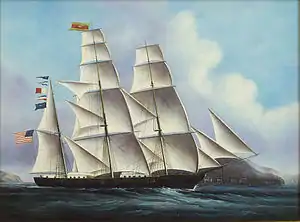 |
1844 | United States (New York, NY) |
Disappeared in 1864 | Unknown | Laid down along lines designed by packet captain Nat Palmer of Stonington, Connecticut. Built by Brown & Bell of New York for the China merchants A.A. Low & Bro, she was launched in 1844, named after a Chinese merchant who had died the previous year. Dogged by ill luck during her career, she disappeared at sea after leaving Yokohama in 1864. |
| Rainbow | 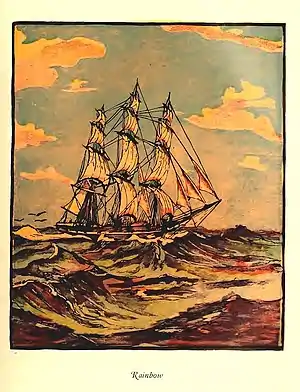 |
1845 | United States (New York, NY) |
Lost in 1848 | 159 ft (48 m) | Rainbow was designed by John W. Griffiths and built by Smith & Dimon of New York for China merchants Howland & Aspinwall. Her design was heavily criticized at the time causing construction to be delayed, while rivals Brown & Bell (also New York based) launched the clipper Houqua for China merchants A.A. Low & Bro. |
| Tartar | — | 1845? | United States (New York, NY) |
Unknown | — | Tartar was a 573-ton ship built in Philadelphia that set a sailing record of 77 days from Holyhead, Wales, to Bombay, India, in 1845 (April 4—June 19), captained by Benoni Lockwood III.[4]: 115 |
| Sea Witch | 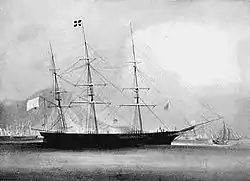 |
1846 | United States (New York, NY) |
Wrecked in 1856 | 170.3 ft (51.9 m) | She was built by Smith & DiMonte of New York for owners Howland & Aspinwall. Her 140 ft mainmast carried 5 tiers of sails, as did the shorter fore and mizzen masts. In 1849, she made a record-setting run from Hong Kong to New York in 74 days under Captain Robert "Bully Bob" Waterman. The previous record had also been set by the same captain with the Sea Witch two years prior with a time of 77 days. |
| Memnon | _(c112-02-03).jpg.webp) |
1848 | United States (New York, NY) |
Lost in 1851 | 170 ft (52 m) | |
| Ticonderoga | — | 1849 | United States (New York, NY) |
Wrecked in 1872 | 169 ft (52 m) | A 169 ft. 4-masted clipper displacing 1,089 tons, launched at Williamsburg, New York. The Ticonderoga was infamous for her "fever ship" voyage in 1852 from Liverpool to Port Phillip carrying 795 passengers. 100 passengers died during the voyage of what was later determined to have been typhus. |
1850s
| Name | Image | Year of launch | Build location | Fate | Length overall |
Short summary |
|---|---|---|---|---|---|---|
| Game Cock |  |
1850 | United States (Boston, MA) |
Condemned in 1880 | 200 ft (61 m) | |
| Mandarin |  |
1850 | United States | 156 ft (48 m) | Built to be the fastest sailing ship, she completed 10 voyages before running aground and being abandoned in the East Indies[5] | |
| Race Horse | — | 1850 | United States (Boston, MA) |
Disappeared in 1865 | 128 ft (39 m) | She was an 1850 clipper barque, who set a record of 109 days from New York to San Francisco during the first Clipper Race around the Horn. |
| Sea Serpent | 1850 | United States (Portsmouth, NH) |
Abandoned in 1891 | 212 ft (65 m) | ||
| Stag Hound | 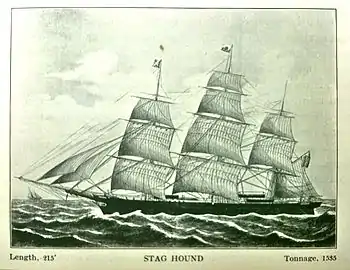 |
1850 | United States (Boston, MA) |
Burned in 1861 | 226 ft (69 m) | Stag Hound was designed by Donald McKay, and built in Boston in anticipation of the California Gold Rush. She was owned Sampson & Tappan (based in Boston), and when completed was the largest vessel in the American merchant marine. Stag Hound was a newer style of clipper which was designed for speed. Under Captain Josiah Richardson, she made a voyage from San Francisco to Canton, China in record time. Her around the world voyages paid for the ship and earned $80,000 for her owners. Her end came in 1861 when she caught fire off Pernambuco, Brazil. |
| Stornoway | 1850 | United Kingdom (Aberdeen) |
Wrecked in 1873 | 157.8 ft (48.1 m) | Stornoway was a British tea clipper built in Aberdeen, Scotland in 1850. | |
| Surprise[6]: 46 [7]: 344 |  |
1850 | United States (Boston, MA) |
Wrecked in 1876 | 183.2 ft (55.8 m) | In hull form, Surprise was a medium clipper, with a prismatic coefficient of 0.82 (compared to Witch of the Wave: 0.66; Sea Witch: 0.64 - typical values for a "sharp" clipper). Nevertheless, she made some notably fast passages, setting a record, at the time, of 96 days and 15 hours on her first trip from New York to San Francisco. She sailed extensively to China. |
| Witchcraft | 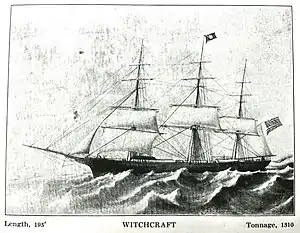 |
1850 | United States (Chelsea, MA) |
Lost in 1861 | 193 ft (59 m) | A clipper ship built by Paul Curtis and Mr. Taylor, and designed by Samuel Hartt Pook. |
| Antelope of Boston | — | 1851 | United States (Medford, MA) |
Abandoned in 1858 | 140 ft (43 m) | |
| Challenge |  |
1851 | United States (New York, NY) |
Wrecked in 1876 | 224 ft (68 m) | Built by William H. Webb in NYC for the San Francisco run, Challenge was captained by Robert Waterman and was expected to beat the extreme clipper Flying Cloud. Brutal treatment of inexperienced crew by Waterman and first mate James Douglass caused riots when San Franciscans heard of the first passage. She was ultimately wrecked off Ushant in 1876. |
| Comet | 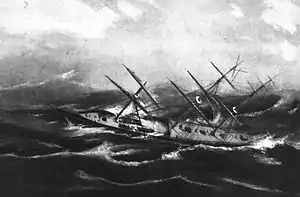 |
1851 | United States (New York, NY) |
Sank in 1865 | 241 ft (73 m) | A California clipper built by William H. Webb which sailed in the Australia trade and the tea trade. This extreme clipper was very fast. She had record passages on two different routes: New York City to San Francisco, and Liverpool to Hong Kong, and beat the famous clipper Flying Dutchman in an 1853 race around the Horn to San Francisco. |
| Eastern State | — | 1851 | United States (Frankfort, ME) |
Sold in 1866 (fate unknown) |
159 ft (48 m) | Built by George Dunham, Frankfort, ME. 813 tons. 159'x29'x21.6'. Captain Paron C. Kilburn. Departs New York Feb 13, 1852; arrives San Francisco July 12, 1852. Later China. In Callao, Peru July, 1854. In Hampton Roads, VA October 1854. In New York October 18, 1854. 1866 sold to British. |
| Flying Cloud[8] |  |
1851 | United States (Boston, MA) |
Burned in 1875 | 225 ft (69 m) | The Flying Cloud was built by Donald McKay, and owned by Grinnell, Minturn & Co which was based out of Boston. In 1854, she set a record of 89 days 8 hours for her trip from New York to San Francisco under Captain J. P. Creasy. Flying Cloud had one sister ship named Northern Light, and was a second copy of the new design that produced the fastest clipper ships. |
| Flying Fish |  |
1851 | United States (Boston, MA) |
Wrecked in 1858[lower-alpha 1] | Unknown | She was launched at East Boston, Massachusetts, for Messrs. Sampson & Tappan, Boston. Under Captain Edward Tappan, she made a run from New York to San Francisco in 92 days. She wrecked on 23 November 1858 off Fuzhou, China en route to New York with a cargo of tea. The wreck was sold to a Manila merchant. After she was rebuilt at Whampoa, China she was renamed the El Bueno Suceso. |
| Harriet Hoxie | — | 1851 | United States (Mystic, CT) |
Sold in 1859 fate unknown |
— | |
| Hornet |  |
1851 | United States (New York, NY) |
Burned in 1866 | 207 ft (63 m) | Built by Westervelt and Mackay in New York, she is notable for a race in 1853 involving Flying Cloud, and eventually burning at sea in 1866. Her crew took to three lifeboats, only one of which eventually reached Hawaii after a voyage of 4300 miles. |
| Ino | — | 1851 | United States (New York, NY) |
Sold in 1886 (fate unknown) |
160.6 ft (49.0 m) | |
| Marco Polo | 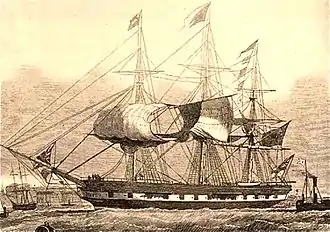 |
1851 | Province of Canada (Saint John, NB) |
Wrecked in 1884 | 184.1 ft (56.1 m) | In 1852 she made England-Australia round trip in less than 6 months. |
| N.B. Palmer[9] | 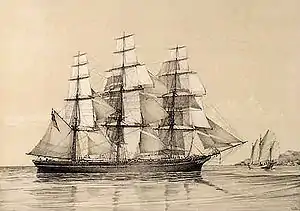 |
1851 | United States (New York, NY) |
Abandoned in 1892 | 202.6 ft (61.8 m) | |
| Nightingale[10] | 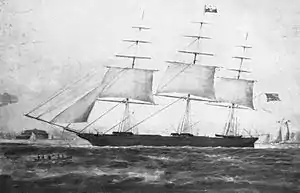 |
1851 | United States (Eliot, ME) |
Abandoned in 1893 | 177 ft (54 m) | |
| North America | — | 1851 | United States (Boston, MA) |
Sold in 1865 fate unknown |
195 ft (59 m) | A clipper almost similar in size to The North American, with which she is often misidentified due to the name(see Lloyd’s Register of American Shipping 1859 register 1567 and the same Register for the year 1864), she was designed by Donald McKay in the year 1851 and after service in the USA was sold to South America in 1865 and not listed by LLoyd's afterwards.[11] |
| North American |  |
1851 | United States (Damariscotta, ME) |
Abandoned in 1898 | 194 ft (59 m) | Renamed Marianna VI, Philadelphia and finally Redemptora (1888) as a homage to princess Isabel of Brazil who abolished slavery in that year. A clipper ship built by Algernon Austin of Maine she was employed as an immigration ship during the Gold Rush and the American Civil War. Launched in 1851. Dimensions 194'x 38' x 28'. Almost sunk during her voyage from Brazil to Australia in 1888, she arrived badly damaged at Fremantle (WA) and was soon sold and used in the local trade as a coal hulk until abandoned on the shores of Jervoise Bay (WA) in 1898.[11] |
| Northern Light[12]: 448–451 |  |
1851 | United States (Boston, MA) |
Abandoned in 1862 | 180 ft (55 m) | Medium clipper built in Boston and designed by naval architect Samuel Hartt Pook. In 1853, Northern Light set the record from San Francisco around Cape Horn to an east coast port (Boston) of 76 days 5 hours. |
| Shooting Star | 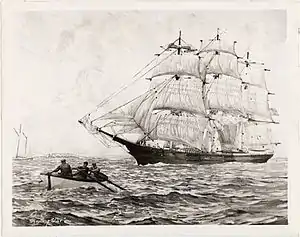 |
1851 | United States (Medford, MA) |
Wrecked in 1867 | 171 ft (52 m) | |
| Snow Squall | 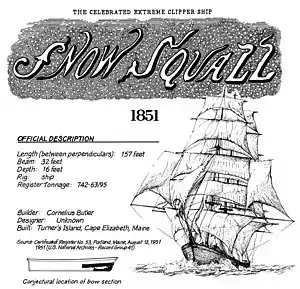 |
1851 | United States (Cape Elizabeth, Maine) |
Condemned in 1864 | 157 ft (48 m) | Snow Squall was a small 800 ton clipper built for the China trade. When she was broken up, the largest surviving piece was used as a dock at Port Stanley in the Falkland Islands. At least 19 feet of her bow was also preserved, and now resides at a museum in Portland, Maine. It is the sole remaining example of the hundreds of American-built clipper ships.[13] |
| Swordfish | — | 1851 | United States (New York, NY) |
Unknown | 169.6 ft (51.7 m) | Swordfish was built by William H Webb, and owned by Barclays & Livingston both of New York. She sailed from New York to San Francisco in 90 days under Captain David S Babcock. |
| Syren |  |
1851 | United States (Medford, MA) |
Unknown | 189 ft (58 m) | Syren sailed in the San Francisco trade, transporting whaling products from Hawaii and the Arctic to New Bedford, Massachusetts. She had a long documented career that lasted until at least 1920, her ultimate fate is unknown. |
| White Squall | — | 1851 | United States | Burned in 1853 | 200 ft (61 m) | White Squall was an 1100-ton fast clipper sailing in the China trade; she was the last command of captain Benoni Lockwood III and burned in a fire in New York Harbor after only 2 years of service.[4]: 255 [14] |
| Witch of the Wave | 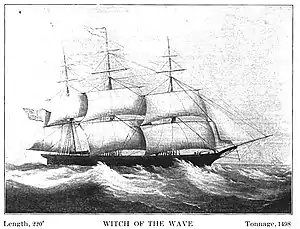 |
1851 | United States (Portsmouth, NH) |
Broken up in 1886 | 220 ft (67 m) | Built by George Raynes of Portsmouth (NH), she held the record passage from Calcutta to Boston. |
| Bald Eagle |  |
1852 | United States (Boston, MA) |
Lost in 1861 | 195 ft (59 m) | Built by Donald McKay; set the record of 78 days 22 hours for a fully laden ship from San Francisco to New York. |
| Carrier Pigeon | — | 1852 | United States (Bath, ME) |
Sank in 1853 | 175.5 ft (53.5 m) | |
| Celestial Empire | 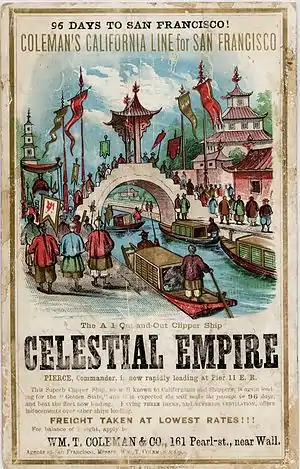 |
1852 | United States (Boston, MA) |
Abandoned in 1878 | 193 ft (59 m) | |
| Challenger (1852) | 1852 | United Kingdom (London) |
Abandoned in 1871 | 174 ft (53 m) | Built by Richard & Henry Green in their Blackwall Yard for Hugh Hamilton Lindsay, London. In 1871 she abandoned at 48°N, 13°W, southwest of the port of Plymouth, England. | |
| Golden South | — | 1852 | United States (Boston, MA) |
Burned in 1893 | 183.9 ft (56.1 m) | |
| Golden West |  |
1852 | United States (Boston, MA) |
Unknown | 210 ft (64 m) | |
| Hippogriffe | — | 1852 | United States (Dennis, MA) |
Unknown | Unknown | Hippogriffe was launched in 1852 from Shiverick Shipyards in East Dennis, MA. It sailed 1,800 miles with a hunk of coral 18 inches in diameter in its hull.[15] |
| John Gilpin | _(c112-01-50).jpg.webp) |
1852 | United States (Boston, MA) |
Abandoned in 1858 | 195 ft (59 m) | She was built by Samuel Hall for owners Pierce, Hunnewell & Company (both Boston). Under Captain Justin Doane, she sailed from New York to San Francisco in 93 days. |
| National Eagle | — | 1852 | United States (Medford, MA) |
Gone by 1884 | 179 ft (55 m) | Medium clipper of New York built by Built 1852 in Medford, Mass. By Joshua T. Foster and Co. for Fisher & Co. of Boston – 996 tons, 179’ x 36’ x 24’. In 1854, she sailed from Boston to San Francisco in 134 days. She was driven ashore near Bari, Italy on her voyage to Flume, Austria. [16] |
| Onward | — | 1852 | United States (Medford, MA) |
Sold in 1884 (fate unknown) |
175 ft (53 m) | |
| Sea Nymph | _(c112-02-24).jpg.webp) |
1852 | United States (Fairhaven, MA) |
Lost in 1861 | — | Sea Nymph was built in Fairhaven, MA and at 1253 tons, was one of the largest ships of her time. She was employed in the New York to San Francisco trade and carried freight as well as passengers. She was ultimately lost in a storm at Point Reyes, California in May, 1861. |
| Sovereign of the Seas |  |
1852 | United States (Boston, MA) |
Wrecked in 1859 | 252 ft (77 m) | Sovereign of the Seas was the fastest and longest ship yet built when she was launched in New York. She was designed and built by Donald Mackay for her owners Funke & Meinke of New York. She sailed from New York to San Francisco on her maiden voyage in 103 days, and achieved the fastest ever recorded speed of a sailing vessel at 22 knots. |
| Westward Ho! | _Some_ships_of_the_clipper_ship_era%252C_their_builders%252C_owners%252C_and_captains%253B_(1913)_0035.jpg.webp) |
1852 | United States (Boston, MA) |
Burned in 1864 | 220 ft (67 m) | |
| Belle of the West[15] | — | 1853 | United States (Dennis, MA) |
Unknown | — | Belle of the West was launched in 1853 from Shiverick Shipyards in East Dennis, Massachusetts. Her captain was William F. Howes. |
| California (1853) | 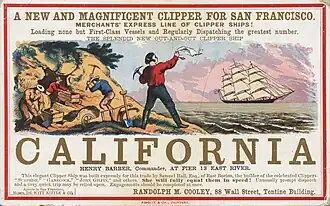 |
1853 | United States (Boston, MA) |
Unknown | — | |
| Challenger (1853) |  |
1853 | United States (Boston, MA) |
Abandoned in 1875 | 206 ft (63 m) | |
| Dreadnought[17][18] |  |
1853 | United States (Newburyport, MA) |
Lost in 1869[19] | 212 ft (65 m) | Dreadnought was a three-masted medium clipper ship built in 1853 by Currier & Townsend at Newburyport, MA. She was originally intended for the "Racehorse Line" of California clippers, but ended up sailing for the Red Cross Line of New York and Liverpool packets. In 1860 she set a new record for New York to Liverpool of only 9 days, 17 hours. She was ultimately lost in 1869. |
| Golden State |  |
1853 | United States (New York, NY) |
Wrecked in 1886 | 188 ft (57 m) | |
| Great Republic |  |
1853 | United States (New York, NY) |
Sunk in 1872 | 400 ft (120 m) | Designed by Donald MacKay and built in New York for owners A A Low & Brother, she was at 335 feet the largest wooden merchant sailing ship ever built, a record that still stands. Before she made her maiden voyage, however, a fire on shore spread to her dock, and she burned to the waterline. She was rebuilt and relaunched. Under Captain Limeburner, she ran from New York to San Francisco in 92 days. |
| Herald of the Morning |  |
1853 | United States (Medford, MA) |
Unlisted in 1891 | 203 ft (62 m) | |
| Kingfisher |  |
1853 | United States (Medford, MA) |
Broken up in 1890 | 217 ft (66 m) | |
| Live Yankee | — | 1853 | United States (Rockland, ME) |
Lost in 1861 | 212 ft (65 m) | Extreme clipper ship built by Horrace Meriam of Rockland Maine. |
| Lookout |  |
1853 | United States (Warren, RI) |
Wrecked in 1878 | 198 ft (60 m) | Built by Chase and Davis for E. Buckley and sons. Wrecked in the Japan Sea after being dismasted in a typhoon, 1878. 198' x38' x 22' 1291 tons. |
| Lord of the Isles[20]: 93–94 [21]: 82 | 1853 | United Kingdom (Greenock) |
Abandoned in 1862 | 210 ft (64 m) | Iron hulled clipper built by Robert Scott & Co., Greenock. Carried tea from Shanghai to London in 96 days in 1855. Won the tea race 1856. Caught fire 24 July 1862 and was abandoned at sea. 770 tons OM, 691 tons NM. | |
| Mimosa | 1853 | United Kingdom (Aberdeen) |
Lost in 1872 | 139.9 ft (42.6 m) | Converted to carry Welsh settlers to Patagonia in 1865. | |
| Neptune's Car | — | 1853 | United States (Portsmouth, VA) |
Unknown | — | This extreme clipper ship was built in 1853 by Page & Allen of Portsmouth, Virginia. Dimensions 216'×40'×23'6" and tonnage 1,616 (of cargo carrying volume—old measurement). Launched April 16, 1853 for Foster & Nickerson, New York. |
| Ocean Chief | — | 1853 | United States (Thomaston, ME) |
Burned in 1862 | — | |
| Orient | .jpg.webp) |
1853 | United Kingdom (London) |
Broken up in 1925 | 184 ft (56 m) | |
| Queen of Clippers |  |
1853 | United States (Boston, MA) |
258 ft (79 m) | She was built at East Boston by Robert E. Jackson, the builder of John Bertram and Winged Racer.[22] | |
| Red Jacket[23] |  |
1853 | United States (Rockland, ME) |
Wrecked in 1885 | 251 ft (77 m) | Red Jacket was designed by Samuel Hartt Pook, and built by the George Taylor yards of Rockland, Maine. During her maiden voyage from New York to Liverpool under Captain Asa Eldridge, she set an unbroken dock to dock speed record of 13 days, one hour and 25 minutes. She originally sailed the Liverpool to Melbourne run. In 1854 she set another record from Liverpool to Melbourne of 67 days, 13 hours. In 1870 she was sold into the Canadian timber trade, and in 1882 was sent to the Cape Verde Islands, where she expired as a coal hulk. |
| Romance of the Sea | — | 1853 | United States (East Boston, MA) |
Disappeared in 1863 | 240 feet (73.2 m) | In her nine year life, Romance of the Sea made six round-trip voyages between North Atlantic and Pacific Ocean ports before being lost during her seventh voyage. |
| Sweepstakes | 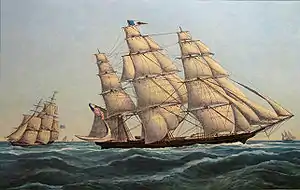 |
1853 | United States (New York, NY) |
Scrapped in 1862 | 216.4 ft (66.0 m) | A clipper built by Westervelt & McKay, and owned by Grinnell, Minturn & Co of Boston. Under Captain George E Lane, she sailed from New York to San Francisco in 94 days. It held the record for the New York-Bombay run. |
| White Swallow |  |
1853 | United States (Boston, MA) |
Unknown | — | |
| Wild Ranger[lower-alpha 2] | — | 1853 | United States (Medford, MA) |
Sank in 1872 | — | |
| Young America | 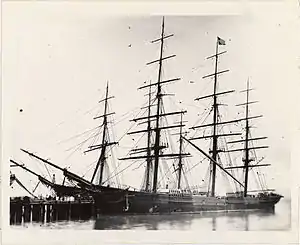 |
1853 | United States (New York, NY) |
Lost in 1886 | 243 ft (74 m) | Built by William Webb of New York. |
| Wide Awake |  |
1853 | United States (New York, NY) |
In 1857 she was sold at Bangkok and sailed for an unknown period under the Siamese flag. | 243 ft (74 m) | Built by Perrine, Patterson & Stack. |
| Blue Jacket | — | 1854 | United States (Boston, MA) |
Burned in 1869 | 235 ft (72 m) | She was an extreme clipper in the Liverpool and Australia trades, named after the blue jackets, a traditional name for sailors in the US and British navies. |
| Champion of the Seas | 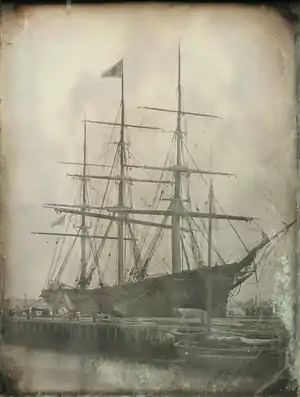 |
1854 | United States (Boston, MA) |
Burned in 1869 | 202 ft (62 m) | Designed by Donald McKay, holds the speed record of 465 miles in 24 hours, set in 1854.[24] |
| Commodore Perry | — | 1854 | United States (Boston, MA) |
Wrecked in 1859 | 252 ft (77 m) | 1967 ton extreme clipper ship built in 1854 by Donald McKay, East Boston for Black Ball line of Australia clippers. |
| Driver | — | 1854 | United States (Newburyport, MA) |
Lost in 1856 | — | |
| Ganges | — | 1854 | United States (Boston, MA) |
Unknown | 192 ft (59 m) | |
| James Baines |  |
1854 | United States (Boston, MA) |
Burned in 1858[lower-alpha 3] | 266 ft (81 m) | Launched on 25 July from the East Boston shipyard of the famous ship builder Donald McKay in the USA for the Black Ball Line of James Baines & Co., Liverpool. achieved 21 knots speed in 1856. Under Captain C. McConnell, she sailed from Boston to Liverpool in 12 days, 6 hours. |
| Kosmopoliet | — | 1854 | Netherlands (Dordrecht) |
Unknown | — | Kosmopoliet was built by the shipyard of Cornelis Gips and Sons in Dordrecht. While two other ships followed; Kosmopoliet II (1865) & Kosmopoliet III (1871), little is known about them. |
| Lightning | ._Messrs_James_Baines_and_Co_Owners_RMG_PU6464.tiff.jpg.webp) |
1854 | United States (Boston, MA) |
Scuttled in 1869 | 277 ft (84 m) | Built by Donald McKay for James Baines of the Black Ball Line, Liverpool, for the Australia trade. Second fastest speed record 436 miles in 24 hours on maiden voyage Boston - Liverpool, and third fastest record of 430 miles in 24 hrs going to Australia. |
| Mary Robinson |  |
1854 | United States (Bath, ME) |
Sank in 1864 | 215 ft (66 m) | |
| Ocean Telegraph[lower-alpha 4] |  |
1854 | United States (Medford, MA) |
Sold in 1883 (Last reported in 1891) |
227 ft (69 m) | Renamed Light Brigade 1863. A clipper ship built for Reed, Wade & Co., Boston for the New York to San Francisco run. Built by James O. Curtis, Medford, Massachusetts, to the design of Boston-based naval architect Samuel Hartt Pook. Launched 29 March 1854. Dimensions 227' × 40' × 23' and tonnage 1495 tons Old Measurement. A very sharp clipper said to be one of the most perfect ships ever built as no expense was spared to make her so. |
| Robin Hood |  |
1854 | United States (Medford, MA) |
Unknown | Unknown | Built in 1854 for Howes & Crowell of Boston, by Hayden & Cudworth of Medford.[25] |
| Santa Claus | _sailing_card.jpg.webp) |
1854 | United States (Boston, MA) |
Sank in 1863 | 194 ft (59 m) | Built by Donald McKay for Joseph Nickerson & Co.[26] |
| Stag | — | 1854 | Province of Canada (LaHave, NS) |
Sank in 1863 | 103.8 ft (31.6 m) | Built in LaHave, Nova Scotia, known for her dramatic Aberdeen bow and fast Atlantic passages. |
| Starlight | .jpg.webp) |
1854 | United States (Boston, MA) |
Unknown | 190 ft (58 m) | |
| Sunny South | 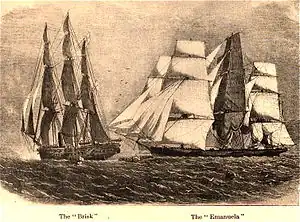 |
1854 | United States (New York, NY) |
Wrecked in 1861 | 135.4 ft (41.3 m) | She was an extreme clipper and only full-sized sailing ship built by George Steers. Initially, she sailed in the California and Brazil trades. Sold in 1859 and renamed Emanuela, she was considered to be the fastest slaver sailing out of Havana. The British Royal Navy captured Emanuela off the coast of Africa in 1860 with over 800 slaves aboard. |
| Tayleur | 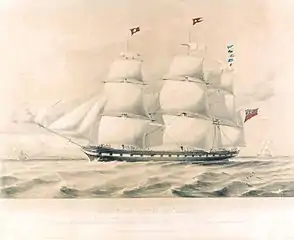 |
1854 | United Kingdom (Liverpool) |
Wrecked in 1854 | 230 ft (70 m) | Designed by William Rennie of Liverpool and built for owners Charles Moore & Company. |
| Abbott Lawrence | 1855 | United States (Boston, MA) |
Unknown | 202.5 ft (61.7 m) | The medium clipper Abbott Lawrence, 1498 tons, was designed by Donald McKay. Her first owners were George B. Upton, John M. Forbes, and Eben Caldwell. Her first captain was Benjamin Hale.[27][28] | |
| Andrew Jackson | 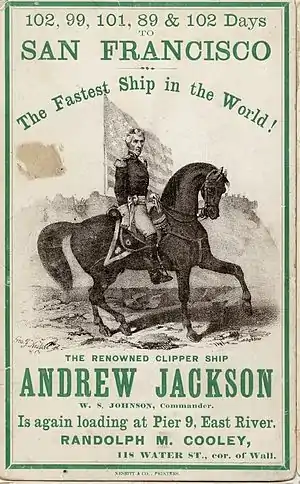 |
1855 | United States (Mystic, CT) |
Wrecked in 1868 | 220 ft (67 m) | Built by Irons & Grinnell of Mystic, CT and owned by J.H. Brower of New York. Under Captain J. E. Williams, it was one of only two clipper ships to complete the New York-San Francisco Cape Horn run in 89 days. |
| Carrier Dove | 1855 | United States (Baltimore, MD) |
Wrecked in 1876 | 220 ft (67 m) | ||
| Donald McKay[29] | 1855 | — | Broken up in 1888 | 266 ft (81 m) | Named after her designer. Extreme clipper, 2594 tons OM, 266 ft, built for James Baines & Co., last extreme clipper ship built by Donald McKay. | |
| Golden Fleece | _(c112-01-40).jpg.webp) |
1855 | United States (Boston, MA) |
Wrecked in 1877 | 222 ft (68 m) | |
| Mary Whitridge[1] | — | 1855 | United States (Baltimore, MD) |
Unknown | 168 ft (51 m) | Built in Baltimore, owned by Thomas Whitridge & Co. She was commanded by Captain Robert B. Cheesborough of Baltimore. She measured at 877 tons, with length of 168 feet, breadth 34 feet, depth 21 feet. On her maiden voyage Mary Whitridge sailed from Cape Charles, Virginia to Liverpool in just 13 days 7 hours. For many years she sailed under Captain Benjamin F. Cutler in the China trade. Clark writes that she was regarded "the finest and fastest ship sailing out of Baltimore" at that time. |
| Royal Charter | .jpg.webp) |
1855 | United Kingdom (Deeside) |
Wrecked in 1859 | 236 ft (72 m) | |
| Schomberg |  |
1855 | United Kingdom (Aberdeen) |
Wrecked in 1855 | — | |
| Thatcher Magoun | 1855 | United States (Medford, MA) |
Lost in 1884 | 200 ft (61 m) | an extreme clipper launched in 1855, was named after the father of ship building on the Mystic, Thatcher Magoun, who died the year that she was launched. | |
| Titan | .jpg.webp) |
1855 | United States | Abandoned in 1858 | Unknown | She was built in 1855 by Roosevelt & Joyce at New York, and was owned by D. G. & W. Bacon of Boston. She was commanded at different times by Captain Oliver Eldridge and J. Henry Sears, both of Boston. Her maiden voyage was a charter carrying French troops to the Crimea. In 1857 she carried 6,900 bales of cotton from New Orleans to Liverpool, the largest cargo of cotton ever shipped up to that date by a sailing vessel. The London Times said of her in 1857, "Titan, the largest and finest clipper in the world, has just returned from the Crimea, and will run in the White Star Line to Australia." Subsequently she sailed to Melbourne and back. In 1857 a gale off Liverpool forced her to cut away the main and mizzen masts in order to wear, and thus she made her way into Liverpool. The next year she was abandoned at sea.[30] |
| Wild Hunter[15] | — | 1855[15] | United States (Dennis, MA) |
Unknown | Unknown | |
| King Philip | 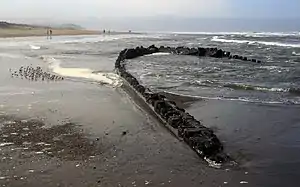 |
1856 | United States (Alna, ME) |
Wrecked in 1878 | 182 ft (55 m) | |
| Lammermuir[20]: 103–104 | 1856 | United Kingdom (Sunderland) |
Wrecked in 1863 | 178 ft (54 m) | Built by William Pile of Sunderland for John "Jock" "White Hat" Willis & Son - probably his first clipper. Wrecked on the Amherst Reef in the Macclesfield Channel, Gaspar Strait on 31 December 1863. 178' x 34' x 22', 953 NRT. | |
| Robin Hood[20]: 104–106 | .jpg.webp) |
1856 | United Kingdom (Aberdeen) |
Sank in 1864 | 204 ft (62 m) | A fast, fine-lined tea clipper. Fastest run back from China was 99 days from Fuzhou (Foochow) to London in 1858 during the Southwest Monsoon. |
| Duncan Dunbar | .png.webp) |
1857 | United Kingdom (Sunderland) |
Wrecked in 1865 | 260 ft (79 m) | |
| Newcastle |  |
1857 | United Kingdom (Sunderland) |
Wrecked in 1883 | Unknown | |
| Windsor Castle | .jpg.webp) |
1857 | United Kingdom (Sunderland) |
Wrecked in 1884 | 195.5 ft (59.6 m) | |
| Ellen Rodger |  |
1858 | United Kingdom (Greenock) |
Wrecked in 1886 in the Gaspar Strait.[31] | 155.66 ft (47.45 m) | A fullrigged wooden clipper built in 1858 by Robert Steele & Co., Greenock. |
| Scawfell[20]: 115–116 [32] | — | 1858 | United Kingdom (Workington) |
Abandoned in 1883 | 198 ft (60 m) | Built of wood, strengthened by iron braces, by Charles Lamport of Workington, Cumberland. In 1861 she made the record voyage under Captain Robert Thomson of 88 days from Whampoa to Liverpool (85 days pilot to pilot). |
1860s
| Name | Image | Year of launch | Build location | Fate | Length overall |
Short summary |
|---|---|---|---|---|---|---|
| Fiery Cross[20]: 120–123 | 1860 | United Kingdom (Liverpool) |
Unknown | 185.0 ft (56.4 m) | First tea clipper home in 1861,1862, 1863 and 1865. Last cargo of tea carried in 1872/73 season. Entered general trade, with the rig reduced, at some point, to barque for economy (as shown in image). | |
| Flying Spur | — | 1860 | United Kingdom (Aberdeen) |
Wrecked in 1881 | 184 ft (56 m) | |
| Great Australia | — | 1860 | United Kingdom (Liverpool) |
Unknown | Unknown | |
| Queen Of Nations | 1861 | United Kingdom (Aberdeen) |
Wrecked in 1881 | Unknown | ||
| The Murray | .jpg.webp) |
1861 | United Kingdom (Aberdeen) |
Unknown | 193.7 ft (59.0 m) | |
| Cornwallis | — | 1862 | Unknown | Unknown | Unknown | |
| Coonatto | .jpg.webp) |
1863 | United Kingdom (London) |
Wrecked in 1876 | 200 ft (61 m) | |
| Cremorne[33] | _(c112-01-17).jpg.webp) |
1863 | United States (Mystic, CT) |
Lost in 1870 | 200 ft (61 m) | Delivered Central Pacific locomotive CP11 to San Francisco, 1865. Left San Francisco for Liverpool, June 1, 1870 and disappeared. |
| Serica[20]: 146 | — | 1863 | United Kingdom (Greenock) |
Wrecked in 1872 | 185.9 ft (56.7 m) | The penultimate wooden-built clipper before Robert Steele's yard changed to composite construction, Serica was the first tea clipper home in 1864 and only beaten by Fiery Cross in 1865 because no tug was available. |
| Three Brothers (clipper) | _-_Bancroft_Library.jpg.webp) |
1862 | United States (New York, NY) |
Scrapped in 1899 | 331.0 ft (100.9 m) | Starboard-side view of three-masted sailing ship, US flag at stern; workers and equipment on deck. Was the USS Vanderbilt before it was sold in 1873 to Howe & Brothers of San Francisco.[34] |
| Taeping[20]: 146–147 | _-_SLV_H91.325-1033.jpg.webp) |
1863 | United Kingdom (Greenock) |
Wrecked in 1871 | 183.7 ft (56.0 m) | The first composite tea clipper built by Robert Steele, Taeping won the 1866 tea race by the closest margin over Ariel. First home in 1867, overtaking Serica who had left 2 days earlier. |
| Wild Deer | _-_natlib.nz_236422.jpg.webp) |
1863 | United Kingdom (Glasgow) |
Wrecked in 1883 | Unknown | China tea clipper of 1016 tons, built in 1863 for the Albion Shipping Co. In 1871 she was chartered by the New Zealand Shipping Co., and diverted to transport immigrants to New Zealand. She made ten voyages to Port Chalmers before being wrecked off Cloughey, County Down, on a trip from Glasgow to Port Chalmers in 1883.[35][36] |
| City of Adelaide | 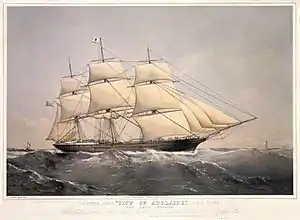 |
1864 | United Kingdom (Sunderland) |
Awaiting restoration | 244.1 ft (74.4 m) | |
| Golden Spur | — | 1864 | United Kingdom (Guernsey) |
Lost in 1879 | Unknown | |
| Lammermuir[37] | — | 1864 | United Kingdom (London) |
Lost in 1876 | 200 ft (61 m) | Built by William Pile of Sunderland for John "Jock" "White Hat" Willis & Son. |
| Ariel[20]: 152–157 |  |
1865 | United Kingdom (Greenock) |
Lost in 1872 | 197.4 ft (60.2 m) | Of composite construction and with lines for good results in light winds, was second tea clipper home in 1866 in an extremely close finish determined by the height of tide to allow entry to her dock. Always thought of as a particularly fast ship. Presumed lost in 1872 due to being pooped by a following sea - her lack of buoyancy aft meant that she was always at risk of this. |
| Fusi Yama | — | 1865 | United Kingdom (Glasgow) |
Sank in 1870 | 165.5 ft (50.4 m) | |
| John R. Worcester | — | 1865 | United Kingdom (Glasgow) |
Unknown | 191.5 ft (58.4 m) | |
| Seminole | — | 1865 | United States (Mystic, CT) |
Unknown | Unknown | |
| Sir Lancelot[20] | 1865 | United Kingdom (Greenock) |
Lost in 1895 | 197.6 ft (60.2 m) | ||
| Taitsing | _off_Hong_Kong.png.webp) |
1865 | United Kingdom (Glasgow) |
Sank in 1883 | 192.0 ft (58.5 m) | |
| Yatala | .jpg.webp) |
1865 | United Kingdom (Aberdeen) |
Wrecked in 1872 | 215 ft (66 m) | |
| Sobraon | 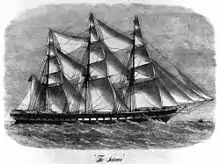 |
1866 | United Kingdom (Aberdeen) |
Broken up in 1941 | 317 ft (97 m)[lower-alpha 5] | |
| Titania | .jpg.webp) |
1866 | United Kingdom (Greenock) |
Broken up in 1910 | 200 ft (61 m) | She was a composite tea clipper built by Robert Steele & Co., Greenock and commanded by Captain Robert "Bobby" Deas, former master of Ganges, in the 1867 tea race. Ariel was her sister ship.[38][39] |
| Lahloo | _-_SLV_H91.250-135.jpg.webp) |
1867 | United Kingdom (Greenock) |
Lost in 1872 | 191.6 ft (58.4 m) | |
| Leander | 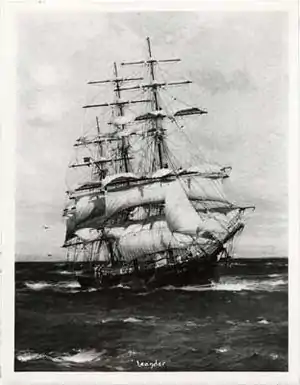 |
1867 | United Kingdom (Glasgow) |
Broken up in 1901 | 215.5 ft (65.7 m) | |
| Kaisow | 1868 | United Kingdom (Greenock) |
Lost in 1891 | 193.2 ft (58.9 m) | ||
| South Australian | .jpg.webp) |
1868 | United Kingdom (Sunderland) |
Lost in 1889 | 201 ft (61 m) | |
| Thermopylae |  |
1868 | United Kingdom (Aberdeen) |
Scuttled in 1907 | 212 ft (65 m) | An extreme composite clipper ship built by Walter Hood & Co of Aberdeen to the design of Bernard Waymouth of London for the White Star Line of Aberdeen. |
| Windhover | — | 1868 | United Kingdom (Glasgow) |
Wrecked in 1889 | 201.1 ft (61.3 m) | |
| Ambassador | 1869 | United Kingdom (London) |
Abandoned in 1895 | 176 ft (54 m) | ||
| Cutty Sark | .jpg.webp) |
1869 | United Kingdom (Dumbarton) |
Museum ship (Greenwich, UK) |
280 ft (85 m) | |
| Glory of the Seas | — | 1869 | United States (East Boston, MA) |
Scrapped in 1923 | 250 feet (76.2 m) | The last merchant sailing vessel built by Donald McKay |
| Miako | — | 1869 | United Kingdom (Sunderland) |
Unlisted in 1912 | 160.1 ft (48.8 m) | |
| Norman Court | 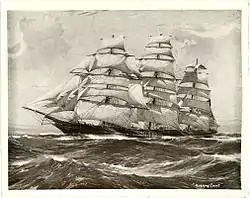 |
1869 | United Kingdom (Glasgow) |
Sank in 1883 | 197.4 ft (60.2 m) | |
| Osaka | .jpg.webp) |
1869 | United Kingdom (Sunderland) |
Wrecked in 1904 | 195 ft (59 m) | |
| Wylo[20] | 1869 | United Kingdom (Greenock) |
Broken up in 1886 | 192.9 ft (58.8 m) |
1870s - 1890s
| Name | Image | Year of launch | Build location | Fate | Length overall |
Short summary |
|---|---|---|---|---|---|---|
| Blackadder | .jpg.webp) |
1870 | United Kingdom (Greenwich) |
Wrecked in 1905 | 216.6 ft (66.0 m) | Blackadder was built by Maudsley, Sons & Field at Greenwich for John Willis. She was the sister ship of Hallowe'en (see entry below). She was wrecked on November 5, 1908 whilst on passage from Barry to Bahia loaded with coal. |
| Hallowe’en | .jpg.webp) |
1870 | United Kingdom (Greenwich) |
Wrecked in 1887 | 216.6 ft (66.0 m) | Built by Maudsley, Sons & Field at Greenwich for John Willis, she was the sister ship to Blackadder. Due to faults in her sister ship which caused dismasting on her maiden voyage, Hallowe'en was not handed over to Willis for nearly 18 months after her launch due to protracted legal action. Hallowe'en was fast in light airs and recorded many fast passages from China. In 1887 she was on passage from Fuzhou (Foochow) loaded with tea and was wrecked off Salcombe in the United Kingdom. |
| Lothair | 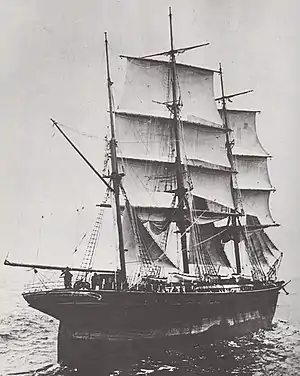 |
1870 | United Kingdom (London) |
Lost in 1910 | 191.8 ft (58.5 m) | Lothair was one of the fastest tea clippers built. On her maiden voyage under Captain Emlyn Peacock, departing London on 10 September 1870, she reached Yokohoma in 135 days.[20] She was later acquired by Killick Martin & Company in 1873, and then by William Bowen in 1885. She was ultimately lost in 1910 for unknown reasons. |
| Loch Ard | _-_SLV_H91.108-1068.jpg.webp) |
1873 | United Kingdom (Scotstoun) |
Wrecked in 1878 | 263 ft (80 m) | Built for the Loch Line, she was one of the last clippers built. Her trading route spanned from Great Britain and Australia, but ended when she ran aground on a reef on June 1, 1878. |
| Rodney | .jpg.webp) |
1874 | United Kingdom (London) |
Wrecked in 1901 | 235.6 ft (71.8 m) | Rodney was an iron-hulled clipper built for the Australian immigration trade. In 1882, she tied a record set by Patriarch (in 1870) by sailing from The Lizard to Sydney in 67 days.[40] She was eventually sold to a new owner in Nantes, and wrecked on the coast of Cornwall in 1901. |
| Loch Vennachar | _-_SLV_H99.220-6.jpg.webp) |
1875 | United Kingdom (Glasgow) |
Wrecked in 1905 | 250 ft (76 m) | |
| Torrens | _-_NMM_P6434.jpg.webp) |
1875 | United Kingdom (Sunderland) |
Broken up in 1910 | 222 ft (68 m) | Built in Sunderland and designed to carry passengers and cargo between London and Port Adelaide, South Australia. She was the fastest ship to sail on that route. Torrens is the last full-rigged composite passenger clipper ever built.[41] She is also the last sailing ship on which Joseph Conrad would serve before embarking on his writing career. |
| Hereward | .jpg.webp) |
1877 | United Kingdom (Glasgow) |
Wrecked in 1898 | 254 ft (77 m) | |
| Florence |  |
1877 | United States
(Maine) |
Foundered 1902 | 225 ft (69 m) | Built in Bath, Maine to transport goods between California and the Eastern US Coast. She disappeared off Cape Flattery during a storm in 1902 and was believed to have sunk. [42] |
| Cimba | .jpg.webp) |
1878 | United Kingdom (Aberdeen) |
Wrecked in 1915 | 223 ft (68 m) | Cimba sailed in the wool trade between London and Sydney for 20 years, from 1878 to 1898. Under her Norwegian owners, Cimba's chief cargo was lumber. She carried firewood from the Baltic to East Indian Dock in Aberdeen Bay, and made a fast passage from Dublin to the St. Lawrence of 14 days. |
| Cromdale | _-_SLV_H91.325-1436.jpg.webp) |
1891 | United Kingdom (Glasgow) |
Wrecked in 1913 | — | Cromdale was the last clipper to be built for the Australian wool trade before it became unprofitable by sail. By the time of her launch, larger vessels such as ocean liners were being built that did not require frequent stops for refueling. |
Modern clipper ships
The following clipper ships were built in the late 20th and early 21st centuries, they were inspired by the historical Clipper era which peaked in the 1850s.
| Name | Image | Year of launch | Build location | Status | LOA | Short summary |
|---|---|---|---|---|---|---|
| Cisne Branco |  |
1999 | Netherlands (South Holland) |
Active | 249 ft (76 m) | Cisne Branco is a steel-hulled full-rigged ship that was built in the style of a classic clipper. She is used as a training ship for the Brazilian Navy.[43] |
| Stad Amsterdam | 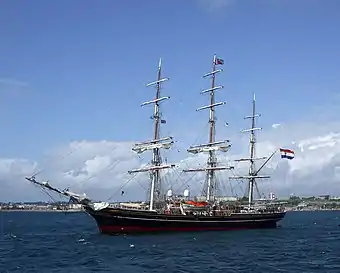 |
2000 | Netherlands (South Holland) |
Active[lower-alpha 6] | 250 ft (76 m) | Stad Amsterdam is a unique modern "extreme" clipper that was intended to be a replica of the mid-19th century frigate Amsterdam. She ended up not being built as a reproduction, and sails as a passenger clipper ship.[44] |
| Shabab Oman II | .jpg.webp) |
2013 | Romania (Galați) |
Active | 285 ft (87 m) | Shabab Oman II was built in Romania for the Royal Navy of Oman as a training vessel. She is designed as a clipper ship with a sailing speed of 17 knots.[45][46] |
See also
Notes
- ↑ The wreck was sold to a Manila merchant, eventually "Flying Fish" was rebuilt at Whampoa, China and renamed El Bueno Suceso.
- ↑ The Wild Ranger was renamed Ocean Chief in 1862 to act as a replacement after the former ship burned (See "Ocean Chief" entry).
- ↑ James Baines was subsequently rebuilt as a coal barge, her final fate is unknown
- ↑ Ocean Telegraph is also known by the name Light Brigade.
- ↑ This may or may not reflect Sobraon's final form, as she was converted from a clipper into a training ship.
- ↑ Stad Amsterdam was modeled after the mid-19th century frigate Amsterdam, but is not a replica due to her hull
References
- 1 2 Clark, Arthur H. (1910). "Chapter 16". The clipper ship era : an epitome of famous American and British clipper ships, their owners, builders, commanders, and crews 1843-1869. New York. p. 254. OCLC 645117240.
 This article incorporates text from this source, which is in the public domain.
This article incorporates text from this source, which is in the public domain. - ↑ Labaree, Benjamin W.; Fowler, William M. Jr.; Hattendorf, John B.; Safford, Jeffrey J.; Sloan, Edward W.; German, Andrew W. (1998). America and the Sea: A Maritime History. Mystic Seaport Museum. pp. 309. ISBN 0-913372-81-1.
- ↑ Edwin Tunis (2002). Oars, Sails and Steam: A Picture Book of Ships. JHU Press. p. 42. ISBN 9780801869327.
- 1 2 Cutler, Carl C. Greyhounds of the Sea: The Story of the American Clipper Ship. Annapolis, MD: U.S. Naval Institute, 1930.
- ↑ Howe, Octavius T. (Octavius Thorndike) (1986). American clipper ships, 1833-1858. Internet Archive. New York : Dover. pp. 378–380. ISBN 978-0-486-25115-8.
- ↑ MacGregor, David R (1993). British and American Clippers: A Comparison of their Design, Construction and Performance. London: Conway Maritime Press Limited. ISBN 0-85177-588-8.
- ↑ Chapelle, Howard I (1968). The Search for Speed Under Sail 1700 - 1855. London: George Allen and Unwin Limited.
- ↑ Bruzelius, Lars (14 December 2003). "Flying Cloud". Sailing Ships: Flying Cloud (1851). The Virtual Maritime Archives. Retrieved 8 May 2010.
- ↑ Bruzelius, Lars (5 April 1996). "N.B. Palmer". Clipper Ships: N.B. Palmer (1851). The Virtual Maritime Archives. Retrieved 8 May 2010.
- ↑ Bruzelius, Lars (11 January 2000). "Nightingale". Sailing Ships: Nightingale (1851). The Virtual Maritime Archives. Retrieved 8 May 2010.
- 1 2 The Clipper Ship Redemptora 1851-1898: A Study in Archaeology, History and Heritage Management
- ↑ Howe, Octavius T.; Matthews, Frederick C. (1986). American clipper ships, 1833-1858. New York: Dover. ISBN 0-486-25116-0.
- ↑ "HAER ME,3-PORTS,2- (sheet 1 of 10) - Clipper Ship SNOW SQUALL Bow, Spring Point Museum, Southern Maine Technical College, South Portland, Cumberland County, ME". Library of Congress. Retrieved 3 May 2020.
- ↑ "The Great Conflagration: Three Clipper-Ships Destroyed: Total Loss of the Great Republic: Burning of the White Squall, and Joseph Walker." New York Times, Dec. 28, 1853.
- 1 2 3 4 Martha R. Lang (14 January 2018). "The ghosts of clipper ships and sea captains in East Dennis". Cape Cod Times. Retrieved 7 July 2019.
- ↑ Freeman, Hattie Atwood (1999). Around the world in 500 days : the circumnavigation of the merchant bark Charles Stewart, 1883-1884, recounted with zest and detail. p. 201.
- ↑ "ShipWiki, Dreadnought". Retrieved 22 March 2012.
- ↑ "New York Times: May 19, 1908". The New York Times. 19 May 1908. Retrieved 25 March 2012.
- ↑ Braynard, Frank Osborn (1978). Famous American Ships; Being an Historical Sketch of the United States As Told Through Its Maritime Life. HASTINGS. p. 94. OCLC 1020240046.
- 1 2 3 4 5 6 7 8 9 10 11 MacGregor, David R. (1983). The Tea Clippers, Their History and Development 1833-1875. Conway Maritime Press Limited. ISBN 0-85177-256-0.
- ↑ Lubbock, Basil (1981) [1914]. The China Clippers. Glasgow: Brown, Son and Ferguson Ltd. ISBN 0851741096.
- ↑ "The New Clipper Ship "Queen of Clippers"". www.bruzelius.info. Retrieved 3 May 2020.
- ↑ Doris A. Isaacson, ed. (1970). Maine: A Guide "Down East" (second ed.). Rockland, Maine: Courier-Gazette, Inc. Maine League of Historical Societies and Museums. pp. 261–262. (First edition).
- ↑ Lyon, Jane D (1962), Clipper Ships and Captains, New York: American Heritage Publishing, p. 138,
Besides the breath-taking 465-nautical-mile (861 km) day's run of the Champion of the Seas, there are thirteen other cases of a ship's sailing over 400 nautical miles (740 km) in 24 hours... And with few exceptions all the port-to-port sailing records are held by the American clippers.
- ↑ "Clipper Ships Built in the United States".
- ↑ Howe, Octavius T. & Matthews, Frederick C. (1927). American Clipper Ships 1833–1858. Vol. II. Salem, MA: Marine Research Society. pp. 544–545. hdl:2027/mdp.39015020225051. OCLC 312241.
- ↑ Cutler, Carl C. (1967). Greyhounds of the Sea. United States Naval Institute. p. 440.
- ↑ McKay, Richard C. (1928). Some Famous Sailing Ships and Their Builder Donald McKay. G.P. Putnam's Sons. p. 372.
- ↑ Lars Bruzelius (5 January 2001). "Donald McKay".
- ↑ Some ships of The Clipper Ship Era, Their Builders, Owners, and Captains. Boston: Boston, Mass. : Printed for the State Street Trust Company. 1913. p. 36.
- ↑ "Sailing Ships: "Ellen Rodger" (1858)". www.bruzelius.info. Retrieved 3 May 2020.
- ↑ "Abandonment of the Scawfell". Shipping and Mercantile Gazette. 31 May 1883.
- ↑ Wendell W. Huffman. "Railroads Shipped by Sea". CPRR.org. Retrieved 9 May 2019.
- ↑ "The Largest Sailing Vessel Aloat-The old Steamship Vanderbilt Remodeled as the Three Brothers". The Brooklyn Daily Eagle. Brooklyn, New York. 20 May 1874. Retrieved 17 August 2020.
- ↑ "The Wild Deer | NZETC". nzetc.victoria.ac.nz. Retrieved 3 May 2020.
- ↑ "Wild Deer (Ship)". Wild Deer (Ship) | Items | National Library of New Zealand | National Library of New Zealand. 1 January 1863. Retrieved 3 May 2020.
- ↑ Lloyd's Register of Shipping. Lloyd's Register. 1871. Retrieved 21 December 2014.
- ↑ "Shady Isle Pirate Society". Shady Isle Pirate Society. Retrieved 3 May 2020.
- ↑ "Sailing Ships: Titania (1866)". www.bruzelius.info. Retrieved 3 May 2020.
- ↑ "The Rodney". www.shipmodelersassociation.org. Retrieved 16 July 2019.
- ↑ J. W. Smith, T. S. Holden (1946). Where Ships are Born: Sunderland 1346-1946; a History of Shipbuilding on the River Wear. Thomas Reed. p. 14.
- ↑ Matthews, F C (1926). "American Ship Florence". Pacific Marine Review. 23: 501, 512 – via Archive.org.
- ↑ Otmar Schäuffelen (2005). Chapman Great Sailing Ships of the World. Hearst Books. p. 27. ISBN 9781588163844.
- ↑ Otmar Schäuffelen (2005). Chapman Great Sailing Ships of the World. Hearst Books. p. 243. ISBN 9781588163844.
- ↑ Najmuz Zafar, M (19 May 2013). "New three mast clipper to replace diplomatic vessel Shabab Oman". Muscat Daily. Retrieved 14 January 2014.
- ↑ "Biography (Shabab Oman II)". Sail training International. Retrieved 11 July 2019.